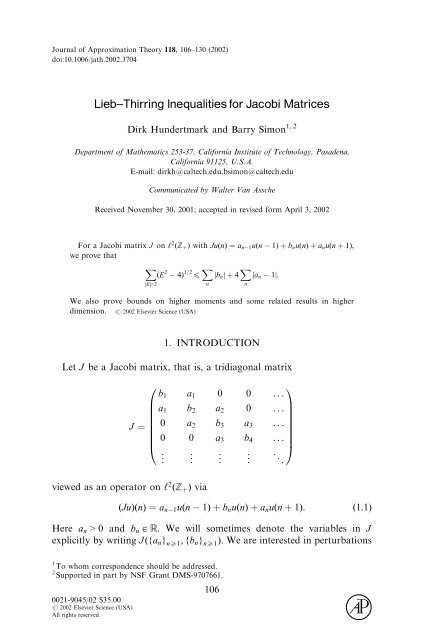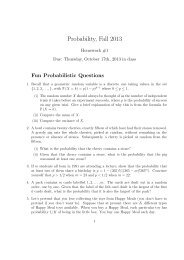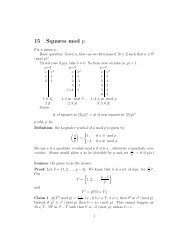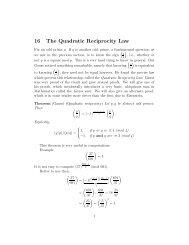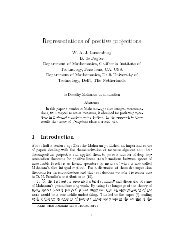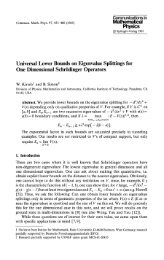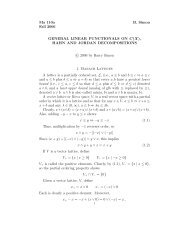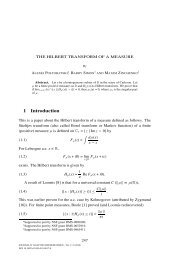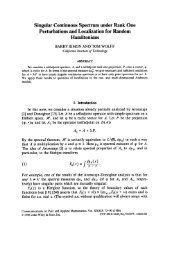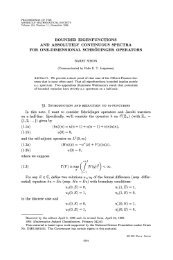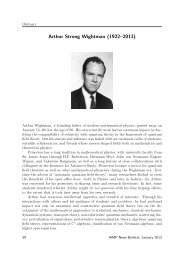Lieb-Thirring Inequalities for Jacobi Matrices - Mathematics ...
Lieb-Thirring Inequalities for Jacobi Matrices - Mathematics ...
Lieb-Thirring Inequalities for Jacobi Matrices - Mathematics ...
You also want an ePaper? Increase the reach of your titles
YUMPU automatically turns print PDFs into web optimized ePapers that Google loves.
Journal of Approximation Theory 118, 106–130 (2002)<br />
doi:10.1006/jath.2002.3704<br />
<strong>Lieb</strong>^<strong>Thirring</strong> <strong>Inequalities</strong> <strong>for</strong> <strong>Jacobi</strong> <strong>Matrices</strong><br />
1, 2<br />
Dirk Hundertmark and Barry Simon<br />
Department of <strong>Mathematics</strong> 253-37, Cali<strong>for</strong>nia Institute of Technology, Pasadena,<br />
Cali<strong>for</strong>nia 91125, U.S.A.<br />
E-mail: dirkh@caltech.edu,bsimon@caltech.edu<br />
Communicated by Walter Van Assche<br />
Received November 30, 2001; accepted in revised <strong>for</strong>m April 3, 2002<br />
For a <strong>Jacobi</strong> matrix J on ‘ 2ðZþÞ with JuðnÞ ¼an<br />
we prove that<br />
1uðn 1ÞþbnuðnÞþanuðn þ 1Þ;<br />
X<br />
ðE 2<br />
4Þ 1=2 4 X<br />
jbnjþ4 X<br />
jan 1j:<br />
jEj>2<br />
n<br />
We also prove bounds on higher moments and some related results in higher<br />
dimension. # 2002 Elsevier Science (USA)<br />
1. INTRODUCTION<br />
Let J be a <strong>Jacobi</strong> matrix, that is, a tridiagonal matrix<br />
0<br />
1<br />
b1 a1 0 0 ...<br />
B<br />
a1 b2 a2 0 ...<br />
C<br />
B<br />
C<br />
B<br />
C<br />
B<br />
J ¼ 0 a2 b3 a3 ... C<br />
B<br />
C<br />
B<br />
0 0 a3 b4 ...<br />
C<br />
B<br />
C<br />
@<br />
A<br />
. . . . .<br />
. . . . . .<br />
viewed as an operator on ‘ 2 ðZþÞ via<br />
n<br />
ðJuÞðnÞ ¼an 1uðn 1ÞþbnuðnÞþanuðn þ 1Þ: ð1:1Þ<br />
Here an > 0 and bn 2 R: We will sometimes denote the variables in J<br />
explicitly by writing Jðfang n51; fbng n51Þ: We are interested in perturbations<br />
1 To whom correspondence should be addressed.<br />
2 Supported in part by NSF Grant DMS-9707661.<br />
0021-9045/02 $35.00<br />
# 2002 Elsevier Science (USA)<br />
All rights reserved.<br />
106
of the special case an 1; bn ¼ 0; called J0; the free <strong>Jacobi</strong> matrix and, in<br />
particular, the case where J J0 is compact, viz., an ! 1; bn ! 0asn !1:<br />
Then sessðJÞ ¼sessðJ0Þ ¼½ 2; 2Š and J has simple eigenvalues fE n g N<br />
n¼1 with<br />
(Nþ or N or both may be infinite)<br />
E þ 1 > Eþ 2 > > 2 > 2 > > E 2 > E 1<br />
: ð1:2Þ<br />
One of our main goals in this paper is to prove the following bound<br />
Theorem 1.<br />
X Nþ<br />
n¼1<br />
½ðE þ n Þ2<br />
4Š 1=2 þ XN<br />
n¼1<br />
½ðE n Þ 2<br />
4Š 1=2 4 X<br />
jbnjþ4 X<br />
jan 1j: ð1:3Þ<br />
As we will see, the constants 1 in front of the b sum and 4 in the an 1<br />
sum are both optimal. Equation (1.3) is optimal in another regime, namely,<br />
large coupling <strong>for</strong> b: Specifically, let Jl be defined with an ¼ a ð0Þ<br />
n and bn ¼<br />
lb ð0Þ<br />
n : Let * b n be a reordering of the bn’s with * bn > 0so * b þ<br />
and * b 1 4 * b 2 4 40: Then it is not hard to see that<br />
n<br />
n<br />
1 5 * b þ<br />
2 5 50<br />
lim<br />
l!1 l 1 E n ðJlÞ ¼ * b n ; ð1:4Þ<br />
which shows that the ratio of the two sides of (1.3) goes to 1 as l !1<strong>for</strong><br />
any bn with P jbnj51:<br />
Since<br />
(1.3) implies that<br />
X<br />
n<br />
ðjE þ n<br />
ðE n Þ 2<br />
4 ¼jE n 2jjE n 2j<br />
5 4jE n<br />
2j 1=2 þjE n þ 2j 1=2 Þ4 1<br />
2<br />
More generally, we will prove<br />
X<br />
n<br />
Theorem 2.<br />
ðjE þ n<br />
LIEB–THIRRING INEQUALITIES FOR JACOBI MATRICES 107<br />
2j;<br />
X<br />
jbnjþ4 X<br />
!<br />
jan 1j : ð1:5Þ<br />
2j p þjEn þ 2j p X<br />
Þ4cp jbnj pþ1=2 þ 4 X<br />
jan 1j pþ1=2<br />
" #<br />
n<br />
n<br />
n<br />
n<br />
ð1:6Þ
108<br />
<strong>for</strong> any p5 1<br />
2 where<br />
cp ¼ 1<br />
2<br />
1=2 Gðp þ 1Þ<br />
3p<br />
Gðp þ 3<br />
2Þ Gð2Þ<br />
Gð3 2Þ: As <strong>for</strong> sums of moments <strong>for</strong> p51 2 ; we will prove<br />
Theorem 3. Let 04p51 2 : Let jj jj be any translation invariant norm on<br />
pairs of sequences fang 1 1<br />
n¼0 ; fbngn¼0 : For any e > 0; there exists a <strong>Jacobi</strong> matrix<br />
with an ¼ 1; bn ¼ 0 <strong>for</strong> n large so that jjða; bÞjj4e but P<br />
n jEþ n 2j p þjEn 2j p 5e 1 :<br />
As (1.4) shows, (1.5) and (1.6) are poor as l !1; since the left side grows<br />
like l p and the right side as l pþ1=2 : It is better to use<br />
and (1.3) to obtain<br />
X<br />
n<br />
and the related.<br />
ðjE þ n<br />
ðE n Þ 2<br />
4 ¼jE n 2jjE n 2j<br />
5 jE n<br />
2j 2<br />
2jþjEn þ 2jÞ4 X<br />
jbnjþ4 X<br />
jan 1j ð1:7Þ<br />
Theorem 4.<br />
X<br />
ðjE<br />
n<br />
þ n 2j p þjEn þ 2j p Þ4 X<br />
ððb<br />
n<br />
þ n þ 2jan 1jÞ p þðbn þ 2jan 1jÞ p Þ<br />
ð1:8Þ<br />
<strong>for</strong> any p5 1<br />
2 :<br />
As (1.4) shows, the ratio of the two sides of (1.8) is 1 as l !1:<br />
We got interested in this problem because Killip–Simon [14] needed a<br />
bound like Theorem 1 to prove a conjecture of Nevai [20, 21] that if the<br />
right-hand side of (1.3) is finite, then a condition of Szeg.o holds. They and<br />
we expected bounds like (1.3) to hold because of the analogous results <strong>for</strong><br />
Schr.odinger operators.<br />
Nevai’s conjecture says that if P<br />
m-function defined by<br />
HUNDERTMARK AND SIMON<br />
n<br />
n<br />
n<br />
jbnjþ P<br />
n jan 1j51; then, with m; the<br />
mðEÞ ¼ðJ EÞ 1<br />
11 ;
we have<br />
LIEB–THIRRING INEQUALITIES FOR JACOBI MATRICES 109<br />
Z 2<br />
dE<br />
log Im mðE þ i0Þ ffiffiffiffiffiffiffiffiffiffiffiffiffi<br />
2<br />
4 E2 p > 1: ð1:9Þ<br />
Killip–Simon [14] use a sum rule of Case [4, 5] that<br />
ZðmÞ ¼ X<br />
logjanjþ X logjbjj; ð1:10Þ<br />
n<br />
where bj is defined by jbjj > 1 and bj þ b 1<br />
j are the listing of the eigenvalues<br />
of J outside ½ 2; 2Š: In (1.10), ZðmÞ is defined by<br />
ZðmÞ ¼ 1<br />
Z 2<br />
log<br />
2p 2<br />
ffiffiffiffiffiffiffiffiffiffiffiffiffi<br />
4 E2 p !<br />
dE<br />
ffiffiffiffiffiffiffiffiffiffiffiffiffi<br />
Im mðE þ i0Þ 4 E2 p : ð1:11Þ<br />
Equation (1.10) is only proven initially <strong>for</strong> J with J J0 finite rank. (Or, in<br />
any event, not initially <strong>for</strong> all J’s with J J0 trace class. Eventually, using<br />
our bounds here and the theory of Nevanlinna functions, Killip–Simon [14]<br />
do prove (1.10) <strong>for</strong> trace class J J0:) Killip–Simon show ZðmÞ is lower<br />
semicontinuous as a trace class J is approximated by cutoff J’s with J J0<br />
finite rank. Thus to prove ZðmÞ51 (i.e., that (1.9) holds), they need to<br />
control the right-hand side of (1.10). Since P jan 1j51; the P<br />
n logjanj is<br />
absolutely convergent. Since jbjj 1 þðjEjj 2Þ 1=2 <strong>for</strong> Ej close to 2; (1.5)<br />
implies that P logjbjj is uni<strong>for</strong>mly bounded.<br />
Theorem 1 should also be interesting in connection with some recent<br />
results of Peherstorfer–Yuditskii [22], who focus on the finiteness of the lefthand<br />
side of (1.3).<br />
Bounds <strong>for</strong> Schr.odinger operator eigenvalues of the <strong>for</strong>m<br />
X 1<br />
n¼1<br />
jEnj p 4Lp;n<br />
Z<br />
R n<br />
jV ðxÞj pþn=2 d n x; ð1:12Þ<br />
where En are the negative eigenvalues of D þ V on L2ðR n Þ; go back 25 years<br />
to the work of <strong>Lieb</strong> and <strong>Thirring</strong> [18, 19], who used the case p ¼ 1; n ¼ 3in<br />
their celebrated proof of the stability of matter. They proved (1.12) <strong>for</strong><br />
p > 0; n52; and p > 1<br />
2 ; n ¼ 1; and shortly thereafter, Cwikel [7], <strong>Lieb</strong> [17],<br />
and Rozenblum [24] proved (1.12) in case p ¼ 0; n53: It is easy to see (e.g.,<br />
[15, pp. 156–157; 26]) that it is false in case p ¼ 0; n ¼ 2:<br />
For many years, the case p ¼ 1<br />
2 ; n ¼ 1 was open. Only in 1996 did Weidl<br />
[27] establish this result <strong>for</strong> p ¼ 1<br />
2 ; n ¼ 1: For n ¼ 1; <strong>Lieb</strong>–<strong>Thirring</strong> [19]<br />
conjectured the optimal value of Lp;n <strong>for</strong> all p51 2 : They proved their<br />
conjecture when n ¼ 1 <strong>for</strong> p ¼ 3 5 7<br />
2 ; 2 ; 2 ; ...; and subsequently, Aizenman–<strong>Lieb</strong><br />
[1] <strong>for</strong> all p53 2 : Shortly after Weidl’s work, Hundertmark et al. [12] found a
110<br />
HUNDERTMARK AND SIMON<br />
new proof which yielded the optimal constant L1=2;1: A partially alternate<br />
proof of a part of the argument in [12] can be found in Hundertmark et al.<br />
[11].<br />
Unlike the discrete case, the continuum theory has a scaling symmetry:<br />
taking V ðxÞ !l 2 V ðlxÞ yields En ! l 2 En since there is a unitary operator<br />
that implements x ! lx: This <strong>for</strong>ces the power jEj p on the right-hand side of<br />
(1.12) given the scaling behavior of dnx: Thus, the same power properly<br />
captures large and small E’s. In the discrete case, this is not so, which is why<br />
we have two bounds (1.5) and (1.8). As noted, (1.8) is good <strong>for</strong> large<br />
coupling, but (1.5) is better <strong>for</strong> small E’s. In particular, if bn n a (with<br />
a > 1) <strong>for</strong> n large, (1.8) only implies P jEþ n 2j p 51 <strong>for</strong> p > a 1 which (1.5)<br />
1 1<br />
implies is true <strong>for</strong> p > a 2 :<br />
Of course, the best extended estimate would involve powers of ðE2 4Þ 1=2<br />
but both the Aizenman–<strong>Lieb</strong> [1] method to increase powers and the Laptev–<br />
Weidl [16] method to increase dimension seem to require powers of<br />
distðE; sessðJÞÞ: However, one can save a little bit of the structure; see the<br />
remark at the end of Section 5.<br />
We note one interesting feature of (1.3) vis-"a-vis the continuum<br />
bound. The continuum p ¼ 1 2 bound has an optimal constant, but is<br />
off by a factor of 2 in the large coupling limit. For (1.3), as we noted above,<br />
the optimal bound <strong>for</strong> small coupling is also exact in the large coupling<br />
limit.<br />
In Section 2, we will prove Theorem 1 when an 1 by closely following<br />
[12] and then obtain Theorems 2 and 4 when an 1 by the now standard<br />
argument of Aizenman and <strong>Lieb</strong> [1]. In Section 3, we make a simple but<br />
useful observation that allows one to obtain estimates <strong>for</strong> eigenvalues <strong>for</strong><br />
arbitrary <strong>Jacobi</strong> matrices from the estimates <strong>for</strong> the special case. Section 4<br />
contains some examples and some counterexamples, and proves Theorem 3.<br />
Section 5 uses ideas of Laptev–Weidl [16] to prove bounds <strong>for</strong> the higherdimensional<br />
case. In Appendix A, we show how the ideas in this paper<br />
provide a simple proof of a strengthening of the Bargmann-type bound of<br />
Geronimo [8, 9].<br />
This paper is aimed towards two rather different audiences: the<br />
Schr.odinger operator community and the orthogonal polynomial community,<br />
who have rather different toolkits. For that reason, we include some<br />
material (such as that at the start of Section 2) that one group or the other<br />
may regard as elementary.<br />
2. BOUNDS FOR DISCRETE SCHR . ODINGER OPERATORS<br />
In this section, we prove Theorems 1, 2, and 4 when all an ¼ 1: We begin<br />
with some general preliminaries. Given any self-adjoint operator A; bounded
from above, we define<br />
E þ j<br />
¼ inf<br />
j 1...j j 1<br />
Similarly, if A is bounded below,<br />
E j ¼ sup<br />
j i...j j<br />
sup<br />
c : c?jj c2D;jjcjj¼1<br />
hc; Aci: ð2:1Þ<br />
inf<br />
c : c?jj c2DðAÞ;jjcjj¼1<br />
hc; Aci: ð2:2Þ<br />
We will use E j ðAÞ if the dependence on A is important. From the definitions,<br />
and<br />
A4B ) E j ðAÞ4E j ðBÞ ð2:3Þ<br />
E1 4E2 4 4E þ 2 4Eþ 1 : ð2:4Þ<br />
The min–max principle [23, Theorem XIII.1] asserts that<br />
(i) E 1 ¼ lim E j has E þ 1 ðAÞ ¼sup sessðAÞ; E 1 ðAÞ ¼inf sessðAÞ:<br />
(ii) If A has N þ (resp. N ) eigenvalues counting multiplicity in the<br />
interval ðE þ 1 ; 1Þ (resp. ð 1; E 1 Þ), these eigenvalues are precisely E 1 ; E 2 ;<br />
...; E N and E j ¼ E 1 if j > N :<br />
Next, note from the definition that if Am ! A in norm, then we have<br />
convergence of the corresponding eigenvalues since jE j ðAÞ E j ðBÞj4jjA<br />
Bjj: It follows if f is an arbitrary continuous nonnegative function, then<br />
so taking k !1;<br />
X 1<br />
j¼1<br />
LIEB–THIRRING INEQUALITIES FOR JACOBI MATRICES 111<br />
X k<br />
j¼1<br />
ðf ðE þ j ðAÞÞ þ f ðE j<br />
f ðE j ðAÞÞ ¼ lim<br />
m!1<br />
ðAÞÞÞ4 lim inf<br />
m!1<br />
4 lim inf<br />
m!1<br />
X 1<br />
j¼1<br />
X k<br />
j¼1<br />
X1 j¼1<br />
Equation (2.5) and the min–max principle imply<br />
f ðE j ðAmÞÞ<br />
f ðE j ðAmÞÞ;<br />
ðf ðE þ j ðAmÞÞ þ f ðE j ðAmÞÞÞ: ð2:5Þ<br />
Proposition 2.1. To prove (1.3)–(1.6), it suffices to prove the special case<br />
where only finitely many an’s differ from 1 and finitely many bn’s differ from 0:
112<br />
Next, we want to note the impact of restriction. Let A be a bounded selfadjoint<br />
operator on H: Let P be an orthogonal projection. By AP ; we mean<br />
PAP restricted as an operator on PH ¼ Ran P: In (2.1)/(2.2), changing from<br />
A to AP adds the condition c 2 Ran P and it decreases sups and increases<br />
infs. Thus,<br />
Proposition 2.2.<br />
E þ j ðAP Þ4E þ j ðAÞ; E j ðAP Þ5E j ðAÞ: ð2:6Þ<br />
We have two applications of (2.6) in mind. First, given two twosided<br />
sequences fang 1<br />
n¼<br />
‘<br />
1<br />
1 ; fbngn¼ 1 ; define the whole-line operator W on<br />
2ðRÞ by<br />
ðWuÞðnÞ ¼an 1uðn 1ÞþbnuðnÞþanuðn þ 1Þ: ð2:7Þ<br />
Thus, if P is the projection of ‘ 2ðZÞ to ‘ 2ðZþÞ ‘ 2ðZÞ; WP ¼ J where J is<br />
built from the projected sequences fang 1<br />
1<br />
n¼1 and fbngn¼1 : As a result, (2.6)<br />
implies<br />
Proposition 2.3. To prove (1.3)–(1.6), it suffices to prove the analogous<br />
result <strong>for</strong> the whole-line operators.<br />
One might think that the results are much harder <strong>for</strong> whole-line<br />
operators. After all, it can be shown that if * b has compact support, then<br />
Jðan 1; bn ¼ l * bnÞ has no spectrum outside ½ 2; 2Š if l is small, but W ðan<br />
1; bn ¼ l * bnÞ always has eigenvalues outside ½ 2; 2Š if l=0; * bc0: That is why<br />
there is a Bargmann bound <strong>for</strong> J but not <strong>for</strong> W : However, it is not harder<br />
because (1.3)–(1.6) have translation invariant quantities <strong>for</strong> their right side.<br />
Let Pn be the projection onto ‘ 2 (m 2 Z; m5n). One can see that as n ! 1;<br />
E j ðWPn Þ!E j<br />
HUNDERTMARK AND SIMON<br />
ðW Þ so (1.3)–(1.6) <strong>for</strong> the <strong>Jacobi</strong> case actually implies it <strong>for</strong><br />
the whole-line case.<br />
The second application of (2.6) is to the study of the following objects that<br />
will play a role below:<br />
S n ðAÞ ¼ Xn<br />
j¼1<br />
Proposition 2.4. Let A be a self-adjoint operator.<br />
E j ðAÞ: ð2:8Þ<br />
(i) Sþ n ðAÞ ¼supfTrðAPÞjP n ¼ P; P 2 ¼ P; TrðPÞ ¼ng:<br />
(ii) Sn ðAÞ ¼inffTrðAPÞjP n ¼ P; P 2 ¼ P; TrðPÞ ¼ng:<br />
(iii) A/Sþ n ðAÞ is convex; A/Sn ðAÞ is concave.
Remark. One can see that if E þ 1 50; then in (i) P 2 ¼ P can be replaced by<br />
04P41 which is how it is often written.<br />
Proof.<br />
(i) By (2.6), S þ n ðAP Þ4S þ n ðAÞ: But since Ran P has dimension n; Sþ n ðAP Þ<br />
¼ TrðAP Þ¼TrðAPÞ: Thus,<br />
S þ n ðAÞ5supfTrðAPÞjP n ¼ P; P 2 ¼ P; TrðPÞ ¼ng:<br />
Next, pick j1; ...; jn as follows. If n4N þðAÞ; take j1; ...; jn to be the<br />
eigenfunctions of A with eigenvalues Eþ 1 ; ...; Eþ n : If n > N þ ; pick j1; ...; jN þ<br />
to be the eigenfunctions <strong>for</strong> A with eigenvalues Eþ 1 ; ...; Eþ<br />
N þ and<br />
jN þþ1; ...; jn to be arbitrary orthonormal vectors in RanðP þ ½E1 e;Eþ 1ŠðAÞÞ;<br />
the range of the spectral projection which is infinite-dimensional when<br />
N þ51 since Eþ 1 ¼ sup sessðAÞ:Let P be the projection onto the span of<br />
j1; ...; jn: Then,<br />
Since e is arbitrary,<br />
LIEB–THIRRING INEQUALITIES FOR JACOBI MATRICES 113<br />
TrðAPÞ ¼ Xn<br />
j¼1<br />
ðj j; Aj jÞ<br />
5 S þ n ðAÞ e½n minðn; N þ ÞŠ:<br />
S þ n ðAÞ4supfTrðAPÞjP n ¼ P; P 2 ¼ P; TrðPÞ ¼ng:<br />
(ii) The same proof as (i).<br />
(iii) S n are the sup and inf of linear functions, so convex and concave,<br />
respectively. ]<br />
As a final general preliminary, we note the Birman–Schwinger principle:<br />
Let A be a self-adjoint operator which is bounded above with a ¼ sup sðAÞ:<br />
Let B be a positive relatively <strong>for</strong>m compact, that is,<br />
Kb B 1=2 ðb AÞ 1 B 1=2<br />
ð2:9Þ<br />
is compact <strong>for</strong> one and hence <strong>for</strong> all b > a: Kb is called the Birman–<br />
Schwinger operator.<br />
Proposition 2.5 (The Birman–Schwinger Principle, Birman [3] and<br />
Schwinger [25]). Let l > 0: b > a is an eigenvalue of A þ lB if and only if
114<br />
Kb has eigenvalue l 1 : We have <strong>for</strong> j4N þ ðA þ lBÞ;<br />
E þ j ðK E þ<br />
j ðAþlBÞÞ ¼l 1 : ð2:10Þ<br />
Remark. The point of (2.10) is that the index j is the same in both E þ j ’s.<br />
Proof. For simplicity, we suppose A and B are bounded operators,<br />
which is true in the applications we will make. If ðA þ lBÞj ¼ bj; then<br />
B 1=2 ðb AÞ 1 B 1=2 ðB 1=2 jÞ¼l 1 B 1=2 j and B 1=2 j=0 since if not, we must<br />
have Aj ¼ bj; which is impossible since b > sup sðAÞ: Conversely, if Kbc ¼<br />
l 1 c and j ¼ðb AÞ 1 B 1=2 c (=0 since l 1 =0), we have ðA þ lBÞj ¼ bj:<br />
Thus the first expression is true.<br />
Next, note that jjKbjj ! 0asb !1by compactness. Its eigenvalues are<br />
continuous, and so by eigenvalue perturbation theory [13, 23], real analytic.<br />
If eðbÞ is a positive eigenvalue of Kb with Kbj ¼ ej and jjjjj ¼ 1; then by<br />
eigenvalue perturbation theory (the Feynman–Hellmann theorem),<br />
de<br />
¼<br />
db<br />
@Kb<br />
j;<br />
@b j ¼ jjðb AÞ 1 B 1=2 jjj 2 50;<br />
so e is strictly monotone. Thus, if eðbÞ is the jth eigenvalue of Kb<br />
eðb0Þ > l<br />
and<br />
1 ; there is exactly one b > b0 with eðbÞ ¼l 1 ; so<br />
#fj j E þ j ðKb 0 Þ5l 1 g¼#fb > b 0 j E þ j ðKbÞ ¼l 1 g<br />
(counting multiplicity) from which (2.10) follows. ]<br />
With the general preliminaries out of the way, we compute the Birman–<br />
Schwinger operator <strong>for</strong> A ¼ W0 and a diagonal (i.e., an 1) perturbation.<br />
Proposition 2.6. Let W0 be the whole-line matrix with an 1; bn 0:<br />
Let b > 2 ¼ sup sðW0Þ: Then ðb W0Þ 1 has matrix elements<br />
where m is related to b by<br />
HUNDERTMARK AND SIMON<br />
½ðb W0Þ 1 Š nm ¼ðm 1<br />
mÞ 1 m jn mj ; ð2:11Þ<br />
b ¼ m þ m 1 ; m51: ð2:12Þ<br />
Remark. Of course, m ¼ 1<br />
2 b<br />
ffiffiffiffiffiffiffiffiffiffiffiffiffi<br />
b 2<br />
q<br />
4 and m 1 ¼ 1<br />
ffiffiffiffiffiffiffiffiffiffiffiffiffi<br />
2 b þ b 2<br />
q<br />
so m<br />
4<br />
1 ffiffiffiffiffiffiffiffiffiffiffiffiffi<br />
m ¼ b 2<br />
q<br />
ffiffiffiffiffiffiffiffiffiffiffiffiffi<br />
4:<br />
This is why E2 p<br />
4 enters in Theorem 1.<br />
Proof. This is a standard calculation. Looking <strong>for</strong> solutions of<br />
jðn 1Þþjðn þ 1Þ ¼bjðnÞ; ð2:13Þ
one tries jðnÞ ¼z n and finds z þ z 1 ¼ b; so the solutions are z ¼ m and m 1 :<br />
Let<br />
j ðnÞ ¼m n :<br />
Both solve (2.13) if m obeys (2.12). Since m51; j þ is ‘ 2 at þ1; j at 1; so<br />
the right-hand side of (2.11) which has the <strong>for</strong>m ðm 1 mÞ 1 j ðminðn; mÞÞ<br />
j þðmaxðn; mÞÞ GnðmÞ is ‘ 2 in m <strong>for</strong> each n with ððW0 bÞGnÞðmÞ ¼0if<br />
m=n: By a direct computation (essentially m 1 m is the Wronskian of j þ<br />
and j ), ðb 0 W ÞGn ¼ dn; that is, GnðmÞ ¼½ðb 0 W Þ 1 dnŠðmÞ; proving<br />
(2.11). ]<br />
Remark. Alternatively, one can use Fourier analysis to compute the<br />
inverse.<br />
Because of (2.11), the following operator will enter in our discussion,<br />
fbng n2Z is a positive sequence of finite support,<br />
ðLmÞ nm ¼ b 1=2<br />
n mjn mj b 1=2<br />
m<br />
Recall the definition (2.8) of Smð Þ: The crucial lemma is<br />
Proposition 2.7. Let 05m5Z41: Then <strong>for</strong> any n;<br />
Remark.<br />
LIEB–THIRRING INEQUALITIES FOR JACOBI MATRICES 115<br />
: ð2:14Þ<br />
S þ n ðLmÞ4S þ n ðLZÞ: ð2:15Þ<br />
(1) Since TrðLmÞ is constant, individual eigenvalues cannot all be<br />
monotone.<br />
(2) This is a special case of the warm-up to the proof of Lemma 4 in<br />
[12]. Our proof is close to the proof there, except where [12] uses eigenvalue<br />
perturbation at m j ¼ 0; we use symmetry.<br />
Proof. Given a bounded positive sequence fmng 1<br />
n¼ 1 ; we define<br />
(<br />
ðLfmngÞk‘ ¼ b1=2<br />
k b1=2<br />
‘<br />
ðLfm ngÞ ‘k<br />
Q ‘ 1<br />
j¼k m j<br />
if k4‘;<br />
if k >‘;<br />
so Lm is Lfm ng when all m n ¼ m: Thus, (2.15) follows if we show S þ n ðLfm ngÞ is<br />
monotone in m n 2½0; 1Þ when fm jg j=n are held fixed. Let f ðmÞ be this<br />
function when m n takes the value m: Lfm jg j=n; m n¼m is affine in m <strong>for</strong> each<br />
matrix element is either constant or a multiple of m: More precisely, in matrix
116<br />
notation we have<br />
Lfm jg j=n;m n¼m ¼<br />
!<br />
A<br />
0<br />
0<br />
B<br />
þ m<br />
0<br />
C<br />
C<br />
w !<br />
0<br />
;<br />
where A; B; and C depend only on fmjgj=n: So by Proposition 2.4(iii), f ðmÞ<br />
is a convex function of m:<br />
On the other hand, if U is the diagonal matrix,<br />
(<br />
jð‘Þ ‘4n;<br />
ðUjÞð‘Þ ¼<br />
jð‘Þ ‘5n þ 1;<br />
or, as a block matrix, U ¼<br />
1<br />
0<br />
0<br />
1 ; then ULfmgU 1 ¼ Lf*mg where<br />
*m ‘ ¼ m (<br />
‘<br />
m ‘<br />
if ‘=n;<br />
if ‘ ¼ n;<br />
that is, we have<br />
U<br />
A<br />
mC<br />
mC<br />
w !<br />
B<br />
U 1 ¼<br />
!<br />
A mC<br />
mC w B<br />
¼ Lfm jg j=n; m n¼ m:<br />
Since Eþ j ; and so Sþ j ; are invariant under unitary trans<strong>for</strong>mations, we see<br />
f ð mÞ ¼f ðmÞ: An even convex function is monotone increasing on ½0; 1Þ;<br />
so Sþ n ðLfmngÞ is monotone in each mn in the region mn50: ]<br />
We are now ready to prove what is essentially Theorem 1 in case an 1:<br />
Theorem 2.8. Let W0 be the free whole-line Schr .odinger operator and B a<br />
positive finite-rank diagonal matrix. Let W ¼ W0 þ B: Then<br />
NþðW XÞ<br />
j¼1<br />
qffiffiffiffiffiffiffiffiffiffiffiffiffiffiffiffiffiffiffiffiffiffiffiffi<br />
ðW Þ2 44TrðBÞ:<br />
ð2:16Þ<br />
E þ j<br />
Proof. (Following Hundertmark et al. [12]). Since B is finite rank, we<br />
know that N þ j ðW Þ51: Define mj by m 1<br />
j þ mj ¼ Eþ j with mj51: By (2.9) and<br />
the remark after Proposition 2.6,<br />
K E þ<br />
j ¼ððEþ j Þ2<br />
with Lm given by (2.14). By (2.10),<br />
HUNDERTMARK AND SIMON<br />
4Þ 1=2 Lm j<br />
ð2:17Þ<br />
E þ j ðKEþÞ¼1: ð2:18Þ<br />
j
Since <strong>for</strong> a > 0; Eþ j ðaAÞ ¼aEþ j ðAÞ; (2.17) and (2.18) imply<br />
qffiffiffiffiffiffiffiffiffiffiffiffiffiffiffiffiffiffiffiffiffiffiffiffi<br />
ðW Þ2 4 ¼ E þ j ðLm Þ: ð2:19Þ<br />
j<br />
Thus,<br />
NX þðW Þ<br />
j¼1<br />
E þ j<br />
qffiffiffiffiffiffiffiffiffiffiffiffiffiffiffiffiffiffiffiffiffiffiffiffi<br />
ðW Þ2 4 ¼ E þ 1 ðLm ÞþE 1 þ 2 ðLm Þþ 2 þE þ N þðLmN þ Þ: ð2:20Þ<br />
E þ j<br />
But, by (2.15) and m 15m 25 5m Nþ 51;<br />
so by induction,<br />
E þ 1 ðLm 1 ÞþE þ 2 ðLm 2 Þ¼S þ 1 ðLm 1 ÞþE þ 2 ðLm 2 Þj<br />
X k<br />
and thus (2.20) implies<br />
LIEB–THIRRING INEQUALITIES FOR JACOBI MATRICES 117<br />
NX þðW Þ<br />
j¼1<br />
j¼1<br />
4 S þ 1 ðLm 2 ÞþE þ 2 ðLmÞ<br />
¼ S þ 2 ðLm 2 Þ<br />
4 S þ 2 ðLm 3 Þ;<br />
E þ j ðLm j Þ4S þ k ðLm k Þ4S þ k ðLm kþ1 Þ<br />
qffiffiffiffiffiffiffiffiffiffiffiffiffiffiffiffiffiffiffiffiffiffiffiffi<br />
ðW Þ2 44<br />
E þ j<br />
XN þ<br />
j¼1<br />
E þ j ðLm¼1Þ ¼TrðBÞ;<br />
since Lm¼1 is the rank one operator b 1=2<br />
n b 1=2<br />
m with a single nonzero eigenvalue<br />
equal to TrðLm¼1Þ ¼TrðBÞ: ]<br />
Remark. The proof shows the inequality is strict if E þ 1 ðLmÞ is strictly<br />
monotone. Thus, the inequality is strict if rank ðBÞ52:<br />
There is a standard argument of Aizenman–<strong>Lieb</strong> [1] which we can use to<br />
go from a ð1 1<br />
2 ; 1Þ bound (power of E 2; power of b) to a general ðp; p þ 2Þ <strong>for</strong> any p51 2 :<br />
Theorem 2.9. Under the hypothesis of Theorem 2.8, we have, <strong>for</strong> any<br />
p5 1<br />
2 ;<br />
NþðW XÞ<br />
j¼1<br />
jE þ j ðW Þ 2jp 4 1<br />
2<br />
Gðp þ 1Þ<br />
Gðp þ 3<br />
2Þ Gð2Þ<br />
Gð3 2Þ TrðjBjpþ1=2Þ: ð2:21Þ
118<br />
Proof. Note first that since bn4ðbnÞ þ maxð0; bnÞ; if positivity of B is<br />
dropped, we still have that<br />
NþðW XÞ<br />
j¼1<br />
jE þ j ðW Þ 2j1=2 4 1<br />
2<br />
X<br />
n<br />
ðbnÞ þ<br />
ffiffiffiffiffiffiffiffiffiffiffiffiffi<br />
by using (2.5), W0 þ B4W0 þ Bþ and E2 p<br />
442jE<br />
2j 1=2 :<br />
Let r > 0: Then<br />
so (2.22) implies<br />
ðE þ j ðW Þ 2 rÞ þ ¼ðE þ j ðW r1Þ 2Þ þ;<br />
NþðW XÞ<br />
j¼1<br />
jE þ j<br />
Now the well-known integral <strong>for</strong> a5p;<br />
Gðp þ 1Þ<br />
Gðp aÞGða þ 1Þ<br />
with scaling implies <strong>for</strong> any a5p:<br />
ð2:22Þ<br />
ðW Þ 2 rj1=2 þ 4 1 X<br />
ðbn rÞ<br />
2<br />
þ: ð2:23Þ<br />
n<br />
a p<br />
þ ¼ Cp;a<br />
Z 1<br />
ð1 xÞ<br />
0<br />
a x p a 1 dx ¼ 1<br />
Z 1<br />
0<br />
ða rÞ a<br />
þ rp a 1 dr; ð2:24Þ<br />
where Cp;a ¼ Gðp þ 1Þ=Gðp aÞGða þ 1Þ: Equations (2.23) and (2.24)<br />
immediately imply that<br />
NþðW XÞ<br />
j¼1<br />
which implies (2.21). ]<br />
Similarly, we have<br />
HUNDERTMARK AND SIMON<br />
jE þ j ðW Þ 2jp4 1<br />
2<br />
C p;1=2<br />
C pþ1=2;1<br />
X<br />
n<br />
ðbnÞ pþ1=2<br />
þ ; ð2:25Þ<br />
Theorem 2.10. Under the hypothesis of Theorem 2.8, we have <strong>for</strong> any<br />
p51;<br />
NþðW XÞ<br />
j¼1<br />
jEjðW Þ 2j p 4TrðjBj p Þ: ð2:26Þ
Proof. Since E52 implies<br />
E 2<br />
4 ¼ðE 2Þ 2 ðE þ 2Þ<br />
5 ðE 2Þ 2 ;<br />
(2.16) implies (2.26) <strong>for</strong> p ¼ 1: The result <strong>for</strong> general p51 follows as above,<br />
where above we get a factor of C p;1=2=C p 1=2;1; here we get Cp;1=Cp;1 ¼ 1: ]<br />
So far, we have proven a bound on Eþ j ; but they immediately imply<br />
bounds on Ej : One can prove that by analogy, but it is even easier to use the<br />
unitary map<br />
which has<br />
so<br />
ðVuÞðnÞ ¼ð 1Þ n uðnÞ;<br />
VW ðfang; fbngÞV 1 ¼ W ðf ang; fbngÞ ¼ W ðfang; f bngÞ;<br />
Thus, <strong>for</strong> example,<br />
LIEB–THIRRING INEQUALITIES FOR JACOBI MATRICES 119<br />
E j ðW ðfang; fbngÞÞ ¼ E þ j ðW ðfang; f bngÞÞ: ð2:27Þ<br />
X Nr<br />
j¼1<br />
jE j ðW Þ 2<br />
4j 1=2 4 X<br />
ð bnÞþ n<br />
¼ X<br />
ðbnÞ ; ð2:28Þ<br />
where x ¼ð xÞ þ ¼ minð0; xÞ; so jxj ¼xþ þ x and we obtain (1.3) <strong>for</strong> the<br />
case an 1:<br />
3. BOUNDS FOR JACOBI MATRICES<br />
an<br />
The following elementary observation lets us pass from bounds in case<br />
1 to the general case. Note that<br />
jan<br />
1<br />
1j 1<br />
jan<br />
!<br />
4<br />
1j<br />
0<br />
!<br />
an<br />
4<br />
0<br />
jan<br />
1<br />
1j 1<br />
jan<br />
!<br />
1j<br />
an<br />
<strong>for</strong> any an real since <strong>for</strong> any x in R; 50 since it has determinant<br />
0 and trace 2jxj50: This immediately implies by repeated use at each pair of<br />
jxj<br />
x<br />
n<br />
x<br />
jxj
120<br />
indices<br />
where<br />
W ðfan 1g; fbn gÞ4W ðfang; fbngÞ4W ðfan 1g; fb þ n gÞ; ð3:1Þ<br />
b n ¼ bn ðjan 1 1jþjan 1jÞ: ð3:2Þ<br />
Equations (3.1) and (2.5) immediately imply<br />
Theorem 3.1. Let f be monotone increasing on ð0; 1Þ and even. Then<br />
f ðE j ðW ðfang; fbngÞÞÞ4f ðE j ðW ðfan 1g; fb n gÞÞÞ; ð3:3Þ<br />
where b n is given by (3.2).<br />
With this, we can now prove our three main theorems:<br />
Proof of Theorem 1. By (3.3), (2.23), and (2.28),<br />
X<br />
ð½ðE<br />
n<br />
þ n Þ2 4Š 1=2 þ½ðEnÞ 2<br />
4Š 1=2 Þ<br />
4 X<br />
ð½bn þjan 1 1jþjan 1jŠþ þ½bn jan 1 1j jan 1jŠ Þ<br />
n<br />
4 X<br />
ð½bnŠþ þ½bnŠ Þþ4 X<br />
jan 1j: ð3:4Þ<br />
n<br />
n<br />
In obtaining (3.4), we used ½x þ yŠ þ4xþ þ yþ and ½x þ yŠ 4x þ y and<br />
that a given jan 1j occurs in four terms with ½bnŠ and ½bnþ1Š : ]<br />
X<br />
n<br />
Proof of Theorem 2. By (3.3), (2.21), and (2.27),<br />
where<br />
ðjE þ n<br />
2j p þ X<br />
jEn þ 2j p X<br />
Þ4 dp<br />
n<br />
HUNDERTMARK AND SIMON<br />
n<br />
ð½bn þjan 1 1jþjan 1jŠ pþ1=2<br />
þ<br />
þ½bn jan 1 1j jan 1jŠ pþ1=2 Þ; ð3:5Þ<br />
dp ¼ 1 Gðp þ 1Þ<br />
2 G p þ 3<br />
Gð2Þ<br />
2 G 3 :<br />
2
Now <strong>for</strong> any q51 (q will be p þ 1<br />
2 ), xq is convex, so<br />
ða þ b þ gÞ q ¼ 3<br />
q a<br />
3<br />
b g<br />
þ þ<br />
3 3<br />
4 3 q 1 ½a q þ b q þ g q Š;<br />
from which (1.6) holds if we note that cp ¼ 3 ðpþ1=2Þ 1 dp: ]<br />
Proof of Theorem 4. As stated, (1.8) is an immediate consequence of<br />
Theorem 2.10 and (3.1).<br />
We kept this bound in <strong>for</strong>m (1.8) to get an exact result as l !1: We<br />
could use the same method of proof of Theorem 2 to get<br />
X<br />
n<br />
jE þ n<br />
2j p þ X<br />
n<br />
jEn þ 2j p p<br />
43<br />
1<br />
X<br />
jbnj<br />
n<br />
p þ 4 X<br />
jan 1j<br />
n<br />
p<br />
q<br />
" #<br />
: ]<br />
We believe it could be true that (1.3) holds with jan 1j replaced by<br />
ðan 1Þþ and, in particular, we know that (1.6) and (1.8) hold when p51 if<br />
jan 1j is replaced by ðan 1Þþ: To see the latter, we note that}by a<br />
convexity plus evenness argument much like that in the proof of Proposition<br />
2.7} Pk j¼1 Eþ j ðW ðfang; fbngÞÞ is monotone in an in the region an50: Thus <strong>for</strong><br />
p ¼ 1; (1.6) and (1.8) hold with ðan 1Þþ <strong>for</strong> we move those a’s with an > 1<br />
to the diagonal as we did in (3.1), and use the monotonicity just noted to<br />
move an’s in ð0; 1Þ up to 1: Once one has the result <strong>for</strong> p ¼ 1; it follows <strong>for</strong><br />
p51 by the Aizenman–<strong>Lieb</strong> argument.<br />
The fact that in (1.6) <strong>for</strong> p51 and in the Bargmann bound of Appendix<br />
A, one can take ðan 1Þþ leads us to conjecture (1.3) holds with ðan 1Þþ rather than jan 1j:<br />
4. EXAMPLES<br />
Example 4.1. W has all an ¼ 1; all n; and all bn ¼ 0 <strong>for</strong> n=0: If<br />
b0 b > 0; then there is an eigenvalue at energy E ¼ m þ m 1 with m51 and<br />
eigenfunction j n ¼ m jnj : To have the eigenfunction fit at n ¼ 0; we need<br />
or<br />
LIEB–THIRRING INEQUALITIES FOR JACOBI MATRICES 121<br />
b ¼ m 1<br />
2m þ b1 ¼ E1<br />
ffiffiffiffiffiffiffiffiffiffiffiffiffi<br />
m ¼ E2 p<br />
4:<br />
This example has equality in (1.3) <strong>for</strong> all values of b > 0 (and also b50 it<br />
turns out) and shows one cannot decrease the value 1 in front on P jbnj:
122<br />
Example 4.2. W has all bn ¼ 0; all n; and all an ¼ 1; n=0: If a0 a > 1;<br />
there is an eigenvalue at energy E ¼ m þ m 1 with 05m51: Then j n ¼ m n<br />
<strong>for</strong> n40 and j n ¼ m n 1 <strong>for</strong> n51 since j must be symmetric around n ¼ 1 2 :<br />
The eigenfunction condition at 0 reads<br />
or a ¼ m 1 : Thus,<br />
m þ a ¼ m þ m 1<br />
a a 1 ffiffiffiffiffiffiffiffiffiffiffiffiffi<br />
¼ E2 p<br />
4:<br />
There is a second eigenvalue at energy E (there has to be by the symmetry<br />
(2.27)). Thus,<br />
LHS of ð1:3Þ ¼2ða a 1 Þ<br />
¼ 2ð1 þ a 1 Þða 1Þ:<br />
The two sides of (1.3) are not equal <strong>for</strong> any a; but the ratio goes to 1 as a # 1<br />
since 2ð1 þ a 1 Þ"4: Thus, the 4 in front of the ja 1j cannot be made<br />
smaller. However, both this example and the discussion in Appendix A<br />
suggest it might be possible to replace ja 1j by ða 1Þ þ:<br />
As noted above, the best constant <strong>for</strong> the W case is the same as <strong>for</strong> the J<br />
case.<br />
Example 4.3. (Proof of Theorem 3). Shift to the <strong>Jacobi</strong> case. Take an<br />
example with an 1andbn¼ 0; except <strong>for</strong> n ¼ m; 2m; ...; Nm where bn ¼ b:<br />
As m ffiffiffiffiffiffiffiffiffiffiffiffiffi !1; there are n eigenvalues above 2 which all approach the solution<br />
of E2 p<br />
4 ¼ b: So long as b51; jEn 2j51 6b2 ; so<br />
X<br />
n<br />
jEn 2j p 5N b2<br />
6<br />
p<br />
: ð4:1Þ<br />
In the translation invariant norm jj jj; let a ¼ jjðan 1; b1 ¼ 1; bn ¼ 0 <strong>for</strong><br />
n=1Þjj: Then <strong>for</strong> the ða; bÞ of this b; N; m example,<br />
Let N0ðeÞ; b 0ðeÞ solve<br />
HUNDERTMARK AND SIMON<br />
jjða; bÞjj4Nab: ð4:2Þ<br />
N b<br />
6<br />
p<br />
¼ 2e 1 ;<br />
Nab ¼ e<br />
2 ;
so<br />
b ¼ c1e 2=1 2p ! 0;<br />
N ¼ c2e ð1þ2pÞ=ð1 2pÞ !1;<br />
since p51 2 : Increase N slightly to be an integer. Thus,<br />
X<br />
jEn 2j p 5e 1 ; jjða; bÞjj4e;<br />
proving Theorem 3.<br />
n<br />
5. BOUNDS IN HIGHER DIMENSION<br />
In this section, we want to use the ideas of Laptev–Weidl [6] to prove<br />
bounds on operators on ‘ 2 ðZ n Þ: We begin with the discrete Schr.odinger<br />
operator case. Let H0 be defined on ‘ 2 ðZ n Þ by<br />
and<br />
LIEB–THIRRING INEQUALITIES FOR JACOBI MATRICES 123<br />
ðH0uÞðnÞ ¼ X<br />
jm nj¼1<br />
uðmÞ<br />
ðVuÞðnÞ ¼V ðnÞuðnÞ:<br />
Lemma 5.1. Let W0 act on ‘ 2ðZ; X Þ where X is a Hilbert space, and let<br />
BðnÞ : X ! X be self-adjoint and trace class with P<br />
n TrðjBðnÞjÞ51: Then,<br />
X<br />
ðEj ðW0 þ BÞ 2<br />
4Þ 1=2 4TrX ðB Þ; ð5:1Þ<br />
j<br />
where B ðnÞ ¼maxð BðnÞ; 0Þ is defined via the functional calculus.<br />
Proof. Suppose BðnÞ50: As with (2.14), define Lm : ‘ 2 ðZ; X Þ!‘ 2 ðZ; X Þ<br />
by<br />
ðLmÞ mn ¼ B 1=2<br />
n mjn mj B 1=2<br />
m :<br />
As with Proposition 2.7, 05m5Z41 implies<br />
S þ n ðLmÞ4S þ n ðLZÞ<br />
and then the proof of (2.16) extends. ]
124<br />
Theorem 5.2. If V 2 LpðZ n ; X Þ <strong>for</strong> p51 where X is a Hilbert space, that is,<br />
V ðxÞ : X ! X is a symmetric compact operator such that P<br />
x2Z n TrX jV ðxÞj p 5<br />
1; then<br />
X<br />
jE þ j ðH0 þ V Þ 2nj p þ X<br />
jEj ðH0 þ V Þþ2nj p 4 X<br />
TrX jV ðxÞj p : ð5:2Þ<br />
j<br />
j<br />
Proof. By the Aizenman–<strong>Lieb</strong> idea, (2.24), it suffices to prove this <strong>for</strong><br />
p ¼ 1: As usual, we can suppose V 50 and prove the result <strong>for</strong> Eþ j : Write<br />
H0 ¼ H0;1 þ H0;f2;...;ng;<br />
where H0;1 involves neighbors in one direction and H0;f2;...;ng neighbors in the<br />
other directions. Note that<br />
and thus<br />
X<br />
ðH0;1 þ H0;f2;...;ng þ V 2nÞ þ<br />
x2Z n<br />
4ðH0;1 þðH0;f2;...;ng þ V 2ðn 1ÞÞ þ 2Þ þ ð5:3Þ<br />
jE<br />
j<br />
þ j ðH0 þ V Þ 2nj ¼Tr ‘ 2 n<br />
ðZ ;X ÞððH0 þ V 2nÞþÞ 4Tr ‘ 2ðZ;‘ 2 n 1<br />
ðZ ;X ÞÞððH0;1 þðH0;f2;...;ng þ V 2ðn 1ÞÞþ 2ÞþÞ 4 X<br />
n1<br />
Tr ‘ 2 ðZ n 1 ;X Þ ððH0;f2;...;ng þ V ðn1; Þ 2n þ 2Þ þÞ<br />
by (5.1) and ðE 2 4Þ 1=2 5ðjEj 2Þ: An inductive argument completes the<br />
proof. ]<br />
For the other moment result, it will be convenient to phrase things in<br />
terms of the classical constants,<br />
Z<br />
L c‘<br />
n=2<br />
p;n ¼ð2pÞ<br />
jkj<br />
jkj41<br />
2p d n k<br />
¼ 2 n n=2 Gðp þ 1Þ<br />
p<br />
Gðp þ 1 þ n<br />
2Þ: ð5:4Þ<br />
These constants have several important features. First, the argument that<br />
led to (2.25) says that if<br />
X Nþ<br />
j¼1<br />
HUNDERTMARK AND SIMON<br />
jE þ j<br />
2j p 4aL c‘<br />
X<br />
p;n jbnj<br />
n<br />
pþn=2<br />
ð5:5Þ
<strong>for</strong> some p ¼ p0; it holds <strong>for</strong> all p > p0: Second,<br />
Lp¼1=2; n¼1 ¼ 2 1 " pffiffiffi#<br />
1<br />
1=2 2 p<br />
p<br />
1<br />
¼ 1<br />
4 ;<br />
so the consequence of (5.1) and ðE2 4Þ 1=2 52ðjEjþ2Þ 1=2 is that (5.5) holds<br />
<strong>for</strong> n ¼ 1; p ¼ 1<br />
2 ; and a ¼ 2:<br />
Finally, we note that from (5.4) and Fubini, we have<br />
L c‘<br />
Yn¼1<br />
p;n ¼ L<br />
j¼0<br />
c‘<br />
pþj=2;1 : ð5:6Þ<br />
Theorem 5.3. Let V 2 Lpþn=2ðZ n ; X Þ <strong>for</strong> p51: Then<br />
X<br />
jE þ j ðH0 þ V Þ 2nj p þ X<br />
jEj ðH0 þ V Þþ2nj p<br />
j<br />
42 n L c‘<br />
p;n<br />
x2Z n<br />
j<br />
X<br />
TrX jV ðxÞj pþn=2 : ð5:7Þ<br />
Proof. We exploit (5.3), but use (5.5) <strong>for</strong> a ¼ 2; n ¼ 1; p51 2 at each stage<br />
of the induction. We then get (5.7) with a constant<br />
by (5.6). ]<br />
LIEB–THIRRING INEQUALITIES FOR JACOBI MATRICES 125<br />
Yn 1<br />
j¼0<br />
2L c‘<br />
pþ1=2;1 ¼ 2n L c‘<br />
p;n<br />
As in the one-dimensional case, Theorem 5.2 is better <strong>for</strong> large coupling.<br />
Indeed, it is exact in the large coupling regime, while Theorem 5.3 gives<br />
more in<strong>for</strong>mation on the eigenvalues very close to 2n in the regime of slow<br />
decay of V ðnÞ at infinity.<br />
As with the one-dimensional case, we can handle nonconstant offdiagonal<br />
terms which approach 1 fast enough at infinity. Let BðZ n Þ be set of<br />
bonds in Z n ; that is, the set of unordered pairs b ¼ðijÞ with i; j 2 Z n ; ji jj ¼<br />
1: Given fabg b2BðZ n Þ; a nonnegative real number ab <strong>for</strong> each bond b ¼ðijÞ;<br />
one can define<br />
The analog of (3.3) is then<br />
ðH0ðabÞuÞðnÞ ¼ X<br />
jm nj¼1<br />
aðnmÞuðmÞ: ð5:8Þ<br />
H0 þ V 4H0ðabÞþV 4H0 þ V þ ; ð5:9Þ
126<br />
where<br />
V ðnÞ ¼V ðnÞ X<br />
jm nj¼1<br />
jaðmnÞ 1j; ð5:10Þ<br />
so, <strong>for</strong> example, we get<br />
X<br />
½E þ j ðH0ðabÞþV ÞþEj ðH0ðabÞþV ÞŠ4 X<br />
jV ðnÞj þ X<br />
4jab 1j: ð5:11Þ<br />
j<br />
Remark. Since the bound in Theorem 1 is optimal both <strong>for</strong> large and<br />
small couplings, the curious reader might wonder whether it is possible to<br />
keep some of its structure also in higher dimension. This is indeed the case.<br />
For constant diagonal terms and scalar potential, we have the two bounds<br />
X<br />
½ðE þ n Þ2 4Š 1=2 þ X<br />
½ðEn Þ 2<br />
4Š 1=2 4 X<br />
jV ðxÞj<br />
and<br />
X<br />
n¼1;...;Nþ<br />
n¼1;...;Nþ<br />
½ðE þ n Þ2<br />
4Š 1=2 þ X<br />
n¼1;...;N<br />
n¼1;...;N<br />
½ðE n Þ 2<br />
n<br />
b<br />
x2Z n<br />
4Š 1=2 42 n 1 L c‘<br />
1;n 1<br />
x2Z n<br />
X<br />
jV ðxÞj 1þðn 1Þ=2 :<br />
Simply use the induction in the dimension idea to strip off the first<br />
coordinate x1 and then use either Theorem 5.2 or 5.3 in n 1 dimension. Of<br />
course, the above extension to nonconstant diagonal terms also applies.<br />
ACKNOWLEDGMENTS<br />
We thank Jeff Geronimo, Fritz Gesztesy, Rowan Killip, and Paul Nevai <strong>for</strong> useful comments.<br />
APPENDIX A. THE BARGMANN BOUND<br />
Our goal in this appendix is to prove<br />
Theorem A.1. Let Nðfag; fbgÞ be the number of eigenvalues of Jðfag;<br />
fbgÞ outside ½ 2; 2Š: Then<br />
where ðxÞ þ ¼ maxðx; 0Þ:<br />
Nðfag; fbgÞ4 X1<br />
HUNDERTMARK AND SIMON<br />
n¼1<br />
ðnjbnjþð4n þ 2Þðan 1Þ þÞ; ðA:1Þ
This is related to a result of Geronimo [8, 9]. We provide a proof here<br />
because it is easy from our machinery earlier. One of Geronimo’s proofs of<br />
this result, Theorem III.1 in [9], has an error in the argument that allows <strong>for</strong><br />
an51; since his Lemma III.1 is wrong. Earlier papers that show N51 if<br />
(A.1) holds include Geronimo–Case [10] and Chihara–Nevai [6].<br />
Note. (1) If you translate Geronimo’s result in [8] into our normalization<br />
1<br />
(he has J0 with a 2 ; not a ¼ 1), then where we have ð4n þ 2Þðan 1Þþ; he<br />
has ð4n þ 4Þðan 1Þþðan þ 1Þ; which is weaker in two regards: 4n þ 254n þ<br />
4 and we have no an þ 1: We note that by looking at bn ¼ 0 and an ¼p1 ffiffiffi <strong>for</strong><br />
n52; one finds examples with N ¼ 2 and ða1 1Þþ arbitrarily pclose<br />
ffiffiffiffiffiffiffiffiffiffiffito<br />
2<br />
1 so that constant in front of ða1 1Þþ must be at least 2ð 2 þ 1Þ<br />
and, in<br />
particular, 4n does not work.<br />
(2) We actually have separate inequalities <strong>for</strong> Nþ and N :<br />
Step 1: an 1; bn50: The proof of Bargmann’s bound [2] given by<br />
Birman [3] and Schwinger [25] works in this case. By (2.10) and the<br />
monotonicity with A ¼ J0; B ¼ J J0; <strong>for</strong> b > 2;<br />
# of eigenvalues of A þ B5b<br />
¼ # of b 0 5b so that K 0<br />
b has eigenvalue ¼ 1<br />
¼ # of eigenvalues of Kb51 ðA:2Þ<br />
4TrðKbÞ ðA:3Þ<br />
4TrðK2Þ; ðA:4Þ<br />
where (A.2) follows from the fact that jjKbjj # 0asb !1 and the strict<br />
monotonicity of the eigenvalues of Kb noted in the proof of Proposition 2.5.<br />
Equation (A.3) holds since<br />
TrðKbÞ ¼ X X<br />
5 5ð# of eigenvalues of Kb51Þ<br />
E þ<br />
j ðKbÞ<br />
E þ j<br />
E þ<br />
j ðKbÞ51<br />
E þ j<br />
since Kb > 0: Equation (A.4) holds since Kb4K2:<br />
The same argument that led to Proposition 2.6 shows that ½ðb J0Þ 1 Šnm ¼ wðbÞ 1 jðbÞðminðn; mÞÞj ðbÞ<br />
þ ðmaxðn; mÞÞ where j solve J0j ¼ bc with jþ 2<br />
L2 at infinity, j ð0Þ ¼0; and w is their Wronskian. As b # 2; jþðnÞ !1;<br />
j ðnÞ !n; and their Wronskian is 1 so<br />
ðK2Þnm ¼ minðn; mÞb 1=2<br />
n b1=2 m<br />
and<br />
LIEB–THIRRING INEQUALITIES FOR JACOBI MATRICES 127<br />
proving (A.1) in this case.<br />
TrðK2Þ ¼ X1<br />
n¼1<br />
nbn;
128<br />
HUNDERTMARK AND SIMON<br />
Step 2: an41; bn50: Let J0ðfangÞ be J with bn ¼ 0: We claim if an41 and<br />
b > 2; then<br />
ðb J0ðfangÞÞ 1<br />
1<br />
nm4ðb J0Þnm : ðA:5Þ<br />
This is a simple maximal principle argument. One first notes that if fnðmÞ ¼<br />
ðb J0ðfangÞÞ 1<br />
nm ; then fnðmÞ > 0 (expand ð1 b 1 JÞ in a geometric series).<br />
Next, one notes that<br />
ððb J0ÞfnÞðmÞ ¼dnm ð1 am 1Þfnðm 1Þ ð1 amÞfnðmÞ<br />
4dnm:<br />
Since ðb J0Þ 1 also has a positive matrix, applying it preserves pointwise<br />
matrix inequalities, so<br />
fnðmÞ4½ðb J0Þ 1 dnŠ m ¼ðb J0Þ 1<br />
nm ;<br />
proving (A.5).<br />
Now (A.5) shows the Birman–Schwinger kernel <strong>for</strong> J0fang and Jðfan; bngÞ<br />
is dominated (in the sense of inequalities on matrix elements) by this <strong>for</strong> J0<br />
and Jðfan 1; bngÞ; so Step 1 implies<br />
TrðK2ðfan; bngÞÞ4TrðK2ðfan 1; bngÞÞ ¼ X1<br />
j¼1<br />
nbn:<br />
Note we do not have an operator inequality of the <strong>for</strong>m ðb J0ðfangÞÞ 1<br />
4ðb J0Þ 1 ; so individual eigenvalues may not have an inequality (this is<br />
Geronimo’s error in [9]).<br />
Step 3: Adding b’s of both signs. Fix an with 05an41: Let JðfbngÞ be the<br />
<strong>Jacobi</strong> matrix with bn along the diagonal and N ðfbngÞ the number of<br />
eigenvalues E with E > 2: Since Jðf ðbnÞ gÞ4JðfbngÞ4JðfðbnÞ þgÞ; we<br />
have<br />
N ðfbngÞ4N ðf ðbnÞ gÞ;<br />
so by (A.1) <strong>for</strong> bn50 and (2.27), we have (A.1) <strong>for</strong> the case 04an41:<br />
Step 4 (General Case): Now use the idea at the start of Section 3 but only<br />
<strong>for</strong> an’s with an > 1: Then (A.1) holds in general since this idea reduces to the<br />
case an41: We use here that<br />
2nðan 1Þ þ þ 2ðn þ 1Þðan 1Þ þ ¼ð4n þ 2Þðan 1Þ þ:
LIEB–THIRRING INEQUALITIES FOR JACOBI MATRICES 129<br />
REFERENCES<br />
1. M. Aizenman and E. H. <strong>Lieb</strong>, On semi-classical bounds <strong>for</strong> eigenvalues of Schr.odinger<br />
operators, Phys. Lett. 66A (1978), 427–429.<br />
2. V. Bargmann, On the number of bound states in a central field of <strong>for</strong>ce, Proc. Nat. Acad.<br />
Sci. U.S.A. 38 (1952), 961–966.<br />
3. M. S. Birman, The spectrum of singular boundary problems, Mat. Sb. (N.S.) 55(97) (1961),<br />
125–174 [in Russian]; Translated in Amer. Math. Soc. Trans. 53 (1966), 23–80.<br />
4. K. M. Case, Orthogonal polynomials from the viewpoint of scattering theory, J. Math.<br />
Phys. 15 (1974), 2166–2174.<br />
5. K. M. Case, Orthogonal polynomials. II, J. Math. Phys. 16 (1975), 1435–1440.<br />
6. T. S. Chihara and P. Nevai, Orthogonal polynomials and measures with finitely many point<br />
masses, J. Approx. Theory 35 (1982), 370–380.<br />
7. M. Cwikel, Weak type estimates <strong>for</strong> singular values and the number of bound states of<br />
Schr.odinger operators, Ann. Math. 106 (1977), 93–100.<br />
8. J. S. Geronimo, An upper bound on the number of eigenvalues of an infinite dimensional<br />
<strong>Jacobi</strong> matrix, J. Math. Phys. 23 (1982), 917–921.<br />
9. J. S. Geronimo, On the spectra of infinite-dimensional <strong>Jacobi</strong> matrices, J. Approx. Theory<br />
53 (1988), 251–265.<br />
10. J. S. Geronimo and K. N. Case, Scattering theory and polynomials orthogonal on the real<br />
line, Trans. Amer. Math. Soc. 258 (1980), 467–494.<br />
11. D. Hundertmark, A. Laptev, and T. Weidl, New bounds on the <strong>Lieb</strong>–<strong>Thirring</strong> constants,<br />
Invent. Math. 140 (2000), 693–704.<br />
12. D. Hundertmark, E. H. <strong>Lieb</strong>, and L. E. Thomas, A sharp bound <strong>for</strong> an eigenvalue<br />
moment of the one-dimensional Schr.odinger operator, Adv. Theor. Math. Phys. 2 (1998),<br />
719–731.<br />
13. T. Kato, ‘‘Perturbation Theory <strong>for</strong> Linear Operators,’’ Springer-Verlag, New York,<br />
1966.<br />
14. R. Killip and B. Simon, Sum rules <strong>for</strong> <strong>Jacobi</strong> matrices and their applications to spectral<br />
theory, Ann. Math., to appear.<br />
15. L. D. Landau and E. M. Lifshitz, ‘‘Quantum Mechanics. Non-relativistic Theory,’’ Course<br />
of Theoretical Physics, Vol. 3, Pergamon Press, London, 1958.<br />
16. A. Laptev and T. Weidl, Sharp <strong>Lieb</strong>–<strong>Thirring</strong> inequalities in high dimensions, Acta Math.<br />
184 (2000), 87–111.<br />
17. E. H. <strong>Lieb</strong>, Bounds on the eigenvalues of the Laplace and Schr.odinger operators, Bull.<br />
Amer. Math. Soc. 82 (1976), 751–753.<br />
18. E. H. <strong>Lieb</strong> and W. <strong>Thirring</strong>, Bound <strong>for</strong> the kinetic energy of fermions which proves the<br />
stability of matter, Phys. Rev. Lett. 35 (1975), 687–689; Errata 35 (1975), 1116.<br />
19. E. H. <strong>Lieb</strong> and W. <strong>Thirring</strong>, <strong>Inequalities</strong> <strong>for</strong> the moments of the eigenvalues of the<br />
Schr.odinger Hamiltonian and their relation to Sobolev inequalities, in ‘‘Studies in<br />
Mathematical Physics. Essays in Honor of Valentine Bargmann’’ (E. <strong>Lieb</strong>, B. Simon,<br />
and A. Wightman, Eds.), pp. 269–303, Princeton Univ. Press, Princeton, NJ, 1976.<br />
20. P. Nevai, Orthogonal polynomials, recurrences, <strong>Jacobi</strong> matrices, and measures, in<br />
‘‘Progress in Approximation Theory,’’ (A.A. Gonchar and E.B. Saff, Eds.), Tampa, FL,<br />
1990, pp. 79–104, Springer Series Computational <strong>Mathematics</strong>, Vol. 19, Springer, New<br />
York, 1992.<br />
21. P. Nevai, Research problems in orthogonal polynomials, in ‘‘Approximation Theory VI,’’<br />
Vol. II, College Station, TX, 1989, pp. 449–489, Academic Press, Boston, 1989.<br />
22. F. Peherstorfer and P. Yuditskii, Asymptotics of orthonormal polynomials in the<br />
presence of a denumerable set of mass points, Proc. Amer. Math. Soc. 120 (2001),<br />
3213–3220.
130<br />
HUNDERTMARK AND SIMON<br />
23. M. Reed and B. Simon, ‘‘Methods of Modern Mathematical Physics, IV. Analysis of<br />
Operators,’’ Academic Press, New York, 1978.<br />
24. G. V. Rozenblum, Distribution of the discrete spectrum of singular differential operators,<br />
Dokl. Akad. Nauk. SSSR 202 (1972), 1012–1015; Izv. Vyssh. Uchebn. Zaved. Mat. 1 (1976),<br />
75–86.<br />
25. J. Schwinger, On the bound states <strong>for</strong> a given potential, Proc. Nat. Acad. Sci. U.S.A. 47<br />
(1961), 122–129.<br />
26. B. Simon, On the number of bound states of two-body Schr.odinger operators: A review, in<br />
‘‘Studies in Mathematical Physics. Essays in Honor of Valentine Bargmann,’’ (E. <strong>Lieb</strong>, B.<br />
Simon, and A. Wightman, Eds.), pp. 305–326, Princeton Univ. Press, Princeton, NJ, 1976.<br />
27. T. Weidl, On the <strong>Lieb</strong>–<strong>Thirring</strong> constants Lg;1 <strong>for</strong> g51=2; Comm. Math. Phys. 178 (1996),<br />
135–146.


